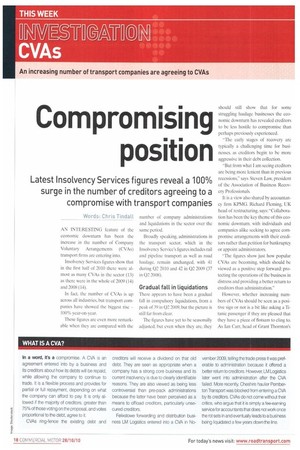Compromisin position
Page 18

Page 19

If you've noticed an error in this article please click here to report it so we can fix it.
Latest Insolvency Services figures reveal a 100% surge in the number of creditors agreeing to a compromise with transport companies
Words: Chris Tindall
AN INTERESTING feature of the economic downturn has been the increase in the number of Company Voluntary Arrangements (CVAs) transport firms are entering into.
Insolvency Services figures show that in the first half of 2010 there were almost as many CVAs in the sector (13) as there were in the whole of 2009 (14) and 2008 (14).
In fact, the number of CVAs is up across all industries, but transport companies have showed the biggest rise 100% year-on-year.
These figures are even more remarkable when they are compared with the number of company administrations and liquidations in the sector over the same period.
Broadly speaking, administrations in the transport sector, which in the Insolvency Service's figures includes rail and pipeline transport as well as road haulage, remain unchanged, with 41 during Q2 2010 and 42 in Q2 2009 (37 in 02 2008).
Gradual fall in liquidations There appears to have been a gradual fall in compulsory liquidations, from a peak of 39 in Q2 2009, but the picture is still far from clear.
The figures have yet to be seasonally adjusted, but even when they are, they should still show that for some struggling haulage businesses the economic downturn has revealed creditors to be less hostile to compromise than perhaps previously experienced.
The early stages of recovery are typically a challenging time for businesses, as creditors begin to be more aggressive in their debt collection.
"But from what I am seeing creditors are being more lenient than in previous recessions," says Steven Law, president of the Association of Business Recovery Professionals It is a view also shared by accountancy firm KPMG. Richard Fleming, UK head of restructuring, says: "Collaboration has been the key theme of this economic downturn, with individuals and companies alike seeking to agree compromise arrangements with their creditors rather than petition for bankruptcy or appoint administrators.
"The figures show just how popular CVAs are becoming, which should he viewed as a positive step forward: protecting the operations of the business in distress and providing a better return to creditors than administration."
However, whether increasing numbers of CVAs should be seen as a positive sign or not is a bit like asking a Titanic passenger if they are pleased that they have a piece of flotsam to cling to. As Ian Carr, head of Grant Thornton's haulage and logistics di % i'ion, says: "Of itself, a doubling of CVAs is had news because more are having to go into insolvency procedures. But the fact that the insolvency practitioners are taking a proper look at projections and for them to be able to approve a CVA is a positive trend."
Mark O'Bornick, director of research and analysis at Analytiqa, describes the rise in CVAs as a "greater 'common sense' approach" prevailing among creditors and insolvency practitioners, but he adds: —This sends out somewhat mixed messages to the market, however. While it's somewhat positive that greater numbers of CVAs are being approved, it also reflects on the higher number of hauliers facing financial difficulty and turning to insolvency procedures in the first place."
What does the future have in store, and does it mean CVA numbers will continue to rise? As Law says, ask two experts their opinions and you will get two very different answers.
James Martin. a partner at Beghies Traynor, says formal insolvencies in the sector were better than the overall average, adding: "Our recent experience in the haulage sector has shown us that, for some companies at least, the wider economic uncertainty has not yet had a major impact."
Construction sector 'active' Martin adds that during the first quarter of 2010 the construction sector "surprised commentators by being quite active".
But he also says that new construction orders fell by 14% between the first and second quarters of this year. which can only spell bad news, and with market liberalisation allowing greater numbers of foreign competition it will continue to be a bumpy ride for hauliers.
O'Bornick says the spending cuts, combined with the increase in VAT in the New Year, will adversely affect transport volumes, putting operators under huge pressure: ''Without doubt, the UK road transport sector will emerge from the recession looking markedly different, as many wellknown, long-established industry names fail, or are swallowed up by competitors," he says. "The extremely challenging trading conditions continue to sec UK hauliers and logistics operators face insolvency on an almost daily basis.
"Growth opportunities remain however, particularly for those that enjoy a multi-sector client base and are therefore less subject to trading conditions in any single industry sector.•
























































































































